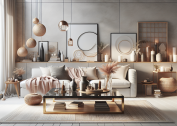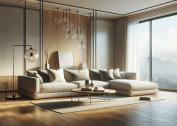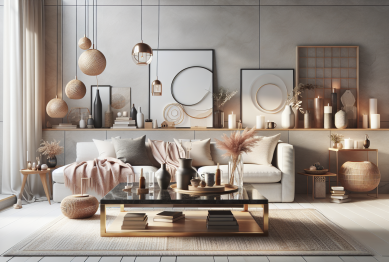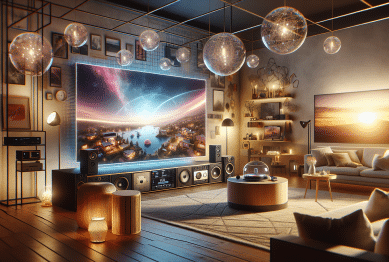In a world driven by aesthetics and convenience, interior design has become more than decoration—it’s a mirror of how we live and what we value. And increasingly, it’s teaching us something deeper: intention matters. What interior design teaches about intention goes beyond color palettes and floor plans. It’s about how space can guide behavior, reduce decision fatigue, and support well-being. As trends shift toward purposeful design choices, more people are learning that interiors shape experiences—and that intentional design can subtly influence the quality of everyday life.

The Rise of Intentional Living Through Design
The renewed interest in intentional living has been gaining traction across lifestyle and entertainment circles. Social media platforms, streaming shows, and design blogs are no longer just showcasing “pretty” rooms. They’re emphasizing how design impacts mood, productivity, and clarity.
Why the shift?
-
Pandemic-era reflection led people to reevaluate how spaces function under pressure.
-
Mental wellness trends prioritize calm, clutter-free environments that support emotional regulation.
-
Work-from-home evolution forced people to turn personal spaces into functional zones—requiring intentional layouts and multipurpose design.
This convergence has turned interior design into a form of daily behavior design.
What Interior Design Teaches About Intention in Practice
The layout, color, texture, and even lighting of a space all influence how we feel and function. When used intentionally, these elements can improve how we move through the day.
Key principles where design meets intention:
-
Zoning for Purpose
-
Instead of open-concept everything, intentional design now favors well-defined zones: a reading corner, a video call background, a tech-free relaxation space.
-
This supports habit-building by aligning space with specific behaviors.
-
-
Function Over Form
-
Beauty still matters, but utility now drives decisions.
-
Furniture with storage, adjustable lighting, and adaptable pieces reflect a design-first, lifestyle-second mindset.
-
-
Negative Space Is Valuable
-
Modern interiors are embracing breathing room.
-
Leaving certain areas empty reduces overstimulation and encourages calm, which can improve mental clarity.
-
-
Material Consciousness
-
More people are choosing natural, sustainable, and sensory-friendly materials—like linen, wood, or cork—because they align with personal values and wellness goals.
-
These choices reflect a cultural shift toward using physical space as an extension of inner clarity.
How Design Shapes Behavior and Mood
Design psychologist Dr. Sally Augustin notes that “environmental cues trigger behavior”. Meaningful design doesn’t just reflect intention—it enforces it.
Examples:
-
Soft, indirect lighting encourages relaxation and helps regulate sleep patterns.
-
Muted color schemes reduce anxiety and create a grounding effect.
-
Natural materials connect occupants to biophilic principles, fostering calm and presence.
The growing field of neuroarchitecture supports this—demonstrating how architecture and interior design directly influence our cognitive and emotional states.
Current Trends Reflecting Intentional Design
1. Warm Minimalism
-
Minimalist design is no longer about stark emptiness. Today’s version adds texture, organic forms, and soft palettes—resulting in spaces that feel intentional, not cold.
2. Wellness-Centric Spaces
-
Home spas, meditation corners, and air-purifying plants are now expected components of residential design.
-
They serve functional roles while supporting emotional well-being.
3. Color with Purpose
-
Instead of following color fads, designers and homeowners are choosing palettes based on emotional response and usage.
-
Earth tones are linked to grounding; blues to focus; greens to calm.
4. Flexible Furniture
-
With spaces serving multiple roles, furniture is becoming modular and responsive—fold-out desks, movable walls, layered lighting.
-
This reflects a core principle: intention must be adaptable.
Lessons for Everyday Life: How to Design With Intention
You don’t need a full renovation to learn what interior design teaches about intention. Small, deliberate adjustments can make a big impact.
Try these strategies:
-
Audit Your Space
-
Walk through your home or workspace and ask: What is this area encouraging me to do?
-
If it’s not clear, the design may be too reactive—not intentional.
-
-
Define Zones by Activity
-
Use rugs, lighting, or shelving to divide spaces by purpose—even in small homes.
-
Example: Use a floor lamp and armchair to create a reading zone, separate from your desk.
-
-
Minimize Visual Clutter
-
Clutter equals cognitive load. Keep surfaces clear and only display what adds meaning or utility.
-
-
Invest in Lighting
-
Lighting changes how a space feels. Cooler light for focus, warmer tones for evening calm.
-
Consider layered lighting to shift ambiance throughout the day.
-
-
Choose Materials That Reflect Your Values
-
Sustainability, durability, or sensory comfort—what matters to you should guide your choices.
-
These intentional steps help your space support—not compete with—your goals.
The Entertainment Industry’s Role in Design Intent
From streaming platforms to editorial content, entertainment media plays a major role in shaping interior trends. But it’s not just about selling furniture—it’s about storytelling.
Popular formats that reinforce intention:
-
Before-and-after transformation series: Show how space reflects personal growth.
-
Design-focused YouTube channels: Focus on problem-solving, not just beauty.
-
TikTok’s “Clean Girl Aesthetic” and “Cluttercore”: Two extremes, both framed around personal intention and mood.
These formats reflect how interior design is now tied to identity, emotional health, and creative control—not just visual appeal.
Why This Shift Matters Culturally
When interior design becomes intentional, it signals more than taste—it represents a mindset. People are moving away from “more stuff equals better” and toward “space that works for me.”
It’s a reflection of larger societal trends:
-
Mindful consumption: Buying less, but choosing better.
-
Emotional self-regulation: Designing environments that soothe instead of stimulate.
-
Identity expression: Using physical space to mirror inner values and aspirations.
In essence, what interior design teaches about intention is a framework for making deliberate choices that reflect and shape the way we want to live.
Conclusion
Design is no longer just about how a room looks—it’s about what a room does. What interior design teaches about intention is the value of thoughtful, deliberate choices. In a time when digital distraction and consumer overload are constant, physical space has become one of the few areas where people can reclaim control.
Whether it’s a curated desk, a quiet bedroom corner, or a streamlined living area, every intentional design decision contributes to clarity, focus, and well-being. And as this mindset continues to grow, interior design will be less about decoration—and more about direction.
References
- Interior Design Magazine – Intentional Interiors “Intentional Interiors Are on the Rise”
https://www.interiordesign.net - Psychology Today – Environment Shapes Habits “Your environment has a silent but profound influence on your daily behaviors… small changes, like moving distractions out of sight, shape behavior” psychologytoday.com
- ANFA (Academy of Neuroscience for Architecture “Neuroarchitecture has recently gained prominence… allows in-depth research into the effect of the environment on human beings” anfarch.org









